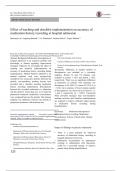Effect of teaching and checklist implementation on accuracy of
medication history recording at hospital admission
Marianne Lea1 • Ingeborg Barstad1,2 • Liv Mathiesen3 • Morten Mowe4,5 • Espen Molden2,6
Received: 25 May 2015/Accepted: 7 November 2015/Published online: 20 November 2015
Koninklijke Nederlandse Maatschappij ter bevordering der Pharmacie 2015
Abstract Background Medication discrepancies at University Hospital, Oslo, Norway
5
hospital admission is an extensive problem and Faculty of Medicine, University of Oslo, Oslo, Norway
knowledge is limited regarding improvement 6
strategies. Objective To investigate the effect of Center for Psychopharmacology, Diakonhjemmet Hospital, Oslo,
Norway
teaching and checklist implementation on
discrepancy. Difference in median number of
accuracy of medication history recording during
discrepancies was included as a secondary
hospitalization. Method Patients admitted to an
endpoint. Results 56 and 119 patients were
internal medicine ward were prospectively
included in period 1 (P1) and period 2 (P2),
included in two consecutive periods. Between the
respectively. There was no significant difference
periods, non-mandatory teaching lessons were
in proportion of patients with minimum one
provided and a checklist assisting medication
discrepancy in P2 (68.9 %) versus P1 (76.8 %, p
history recording implemented. Discrepancies
= 0.36), but a tendency of lower median number
between the recorded medications at admission
of discrepancies was observed in P2 than P1, i.e.
and the patient’s actual drug use, as revealed by
1 and 2, respectively (p = 0.087). Conclusion
pharmacist-conducted medication reconciliation,
More powerful strategies than non-mandatory
were compared between the periods. The primary
teaching activities and checklist implementation
endpoint was difference between the periods in
are required to achieve sufficient improvements
proportion of patients with minimum one
in medication history recording during
hospitalization.
Keywords Medication discrepancies
Electronic supplementary material Medication history recording Medication
The online version of this
article (doi:10.1007/s11096-015-0218-9) contains supplementaryreconciliation Norway Patient safety Quality
material, which is available to authorized users.
improvement
& Marianne Lea
marianne.lea@sykehusapotekene.no
Impact of findings on practice statements
1
Department of Pharmaceutical Services, Oslo Hospital
Pharmacy, Kirkeveien 166, 0450 Oslo, Norway • There is a great potential for improved
2 accuracy of medication history recording at
Department of Pharmaceutical Biosciences, School of
hospital admission in Norway.
Pharmacy, University of Oslo, Oslo, Norway
3 • Medication reconciliation by pharmacists
Hospital Pharmacies Enterprise, South Eastern Norway, Oslo, working in collaboration with physicians,
Norway
4
could be a successful strategy to improve
General Internal Medicine Ward, The Medical Clinic, Oslo patient safety during hospitalization.
123
, Introduction pharmacy cooperation in Norway, and its design
and content was also impacted by representatives
Discrepancies in patients’ medication lists are of the emergency department and internal
reported in up to 70 % of the patients at hospital medicine ward. The checklist was demonstrated
admission [1–3]. However, knowledge is limited for physicians and nurses during teaching and
regarding strategies to reduce medication attached to the hand-written patient chart, hence
discrepancies arising due to hospital admission. always available during the stay. Use of the
Int J Clin Pharm (2016) 38:20–24 checklist was monitored[48 h after the patients’
arrival to the ward.
Aim of the study Two clinical pharmacists (authors ML and IB)
performed the medication reconciliation. Both
The aim of this study was to investigate the effect were trained in medication reconciliation
of teaching and checklist implementation on according to standard procedures of the hospital
accuracy of medication history recording at pharmacy.
hospital admission. 21 Medication reconciliation
The medication reconciliation was based on
Ethical approval procedures from the Integrated Medicines
Management model [4]. In P1, reconciliation was
The study was approved by all relevant conducted within 48 h after the patient’s arrival to
authorities, i.e. the Regional Committee for the ward. In P2, reconciliation was delayed 48 h
Medical and Health Research Ethics (#2011/541 extra to ensure that the ward staff had time to
and #2012/654), the Privacy ombudsman and the complete medication history recording in
Hospital Investigational Review Board. compliance with the checklist.
Patients who self-administered medications
prior to admission were interviewed by the
Method pharmacist about use of drugs, herbal remedies
and dietary supplements. If necessary, general
Study performance practitioners, community pharmacies or patients’
relatives were consulted to complete the
The study was implemented with a before-after
information. For patients assisted with drug
(pre-post) design. Patients admitted to an internal
administration, medication lists were collected
medicine ward were prospectively enrolled
from nursing homes or district nurses. All
during two periods, i.e. September 2011 (period 1
identified drugs were recorded according to the
= P1; before) and November 2012 to February
ATC code system [5].
2013 (period 2 = P2; after). Prior to inclusion, all
Each mismatch between the reconciled
participants gave their written informed consent.
medication list (reference) and the list recorded at
Between P1 and P2, actions to improve
hospital admission was defined as a discrepancy.
accuracy of medication history recording were
When identifying discrepancies during the study
implemented. One comprised non-mandatory
periods, the pharmacists consecutively conducted
teaching lessons for physicians and nurses at the
risk assessments based on their own, professional
internal medicine ward and the emergency
judgements. When physicians were informed
department, focusing on results of medication
about the identified discrepancies, their decisions
reconciliation in P1 and possible consequences of
whether to act or not regarding the issues were
inaccurate medication history recording. A
recorded.
medically responsible physician and a clinical
The discrepancies were categorized in six
pharmacist (author ML) were responsible for this
groups:
classroom-based teaching.
Along with the teaching, a checklist was • commission, i.e. drug not to be used
implemented in the emergency department registered at admission
between P1 and P2, to facilitate registration of • omission, i.e. drug in use missed at admission
medication information during hospitalization and • incorrect strength
transfer to the ward (Supplementary Figure 1). • incorrect formulation
The checklist was result of nationwide clinical • incorrect dosing





